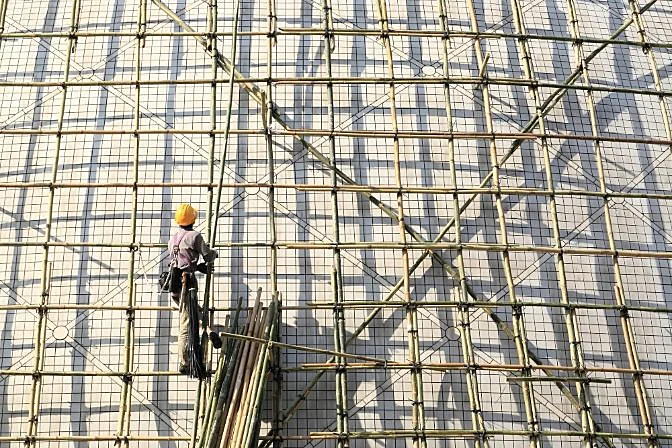Table of Contents
- 1. What Is Terrace Farming?
- 2. A Global History: Where Terracing Began
- 3. What Is The Purpose Of Terrace Farming?
- 4. How Does Terracing Prevent & Reduce Soil Erosion?
- 5. Most Common Types Of Terraces & Terrace Farming Systems
- 6. Engineering Considerations: Slope, Grade, and Design
- 7. Economic and Environmental Benefits Of Terrace Farming
- 8. Crops Grown In Terrace Farming
- 9. The Precision Agriculture Connection: Satellite Crop Monitoring with XRTech Group
- 10. Frequently Asked Questions About Terrace Farming
- 11. The Future of Slope Farming is Precision
For millennia, farmers have faced the challenge of cultivating sloped land without losing their valuable topsoil to rain and runoff. The ingenious solution developed across civilizations, from the rice paddies of Asia to the Andean mountains, is the agricultural terrace. This technique is a profound example of engineering meeting ecology. Today, this sustainable practice is more critical than ever, and its management is being revolutionized by the precision of satellite crop monitoring with XRTech Group.
1. What Is Terrace Farming?
Terrace farming (or terracing farming) is the method of creating level, flat platforms—known as agricultural terraces—on hill or mountain slopes. These steps resemble giant staircases that follow the natural contours of the land. Each flat tier, or terrace farm, acts as an individual, manageable field, fundamentally transforming steep, unusable ground into productive acreage.
The smart part is that water gently moves from the full top steps to the steps below them. This stops soil erosion because the water is spread out nicely across the whole hill instead of rushing quickly to the bottom.
2. A Global History: Where Terracing Began
Terracing is not a new concept; its widespread adoption across vastly different ancient cultures speaks to its universal effectiveness. The practice is documented as far back as 500 BC.
- The Philippines Rice Terraces: Arguably the most famous example, the Banaue Rice Terraces, dating back over 2,000 years, are a UNESCO World Heritage Site. These terraces turn entire mountainsides into irrigated rice paddies, showcasing sophisticated water management.
- The Inca of the Andes: The Inca civilization utilized terraces—known as *andenes*—not just for food crops like potatoes and corn but also to create microclimates. The different elevations allowed them to experiment with various crops, maximizing food security in the challenging mountain environment.
- Mediterranean Vineyards: Terracing is vital in Southern Europe for cultivating grapes, olives, and citrus fruits on steep slopes, preventing the loss of shallow soil layers critical for these perennial crops.
3. What Is The Purpose Of Terrace Farming? Why is terracing necessary?
The necessity of terraced farm systems stems from two primary environmental threats on sloped land: rapid water runoff and severe soil erosion. The core purpose of agricultural terrace construction is to intercept water flowing down a hill. By creating level steps, the system achieves:
Erosion Control
It drastically slows the speed of runoff, preventing the water from gaining the velocity required to carry away nutrient-rich topsoil.
Water Conservation
It encourages water to soak into the soil (infiltration) rather than rush down the slope (runoff), maximizing moisture availability for crops.
Usable Land Creation
It provides a stable, level surface for planting, harvesting, and modern farm equipment.
4. How Does Terracing Prevent & Reduce Soil Erosion?
Terracing farming is perhaps the most effective mechanical method for combating soil erosion. So, what is terracing in soil conservation? It is the practice of converting long, erosive slopes into shorter, contained flat segments. The critical factor is the physical barrier created by the riser (the steep part between the tiers) and the level bench. This structure forces water to stop and pool, depositing any sediment it might be carrying, thereby keeping the topsoil in place. This mechanism is precisely How Does Terracing Prevent & Reduce Soil Erosion? It transforms destructive flow into beneficial infiltration. Terracing combats the three major types of water erosion:
- Sheet Erosion: The uniform removal of thin layers of soil. Terraces stop the water from moving in the first place, halting this subtle but damaging process.
- Rill Erosion: The formation of small channels (rills) of concentrated water flow. The level surface of the terrace breaks up these rills and disperses the flow.
- Gully Erosion: The most severe form, creating deep, large channels. Terraces prevent the water from accumulating the necessary volume and velocity to form gullies.
5. Most Common Types Of Terraces & Terrace Farming Systems
While the general principle is the same, agricultural terraces are adapted based on the slope angle, soil type, and the degree of mechanization required.
Bench Terraces
The classic step-like structure, featuring level beds and steep risers, ideal for rice paddies or very steep slopes (up to 50% grade). These often require manual labor or specialized small machinery.
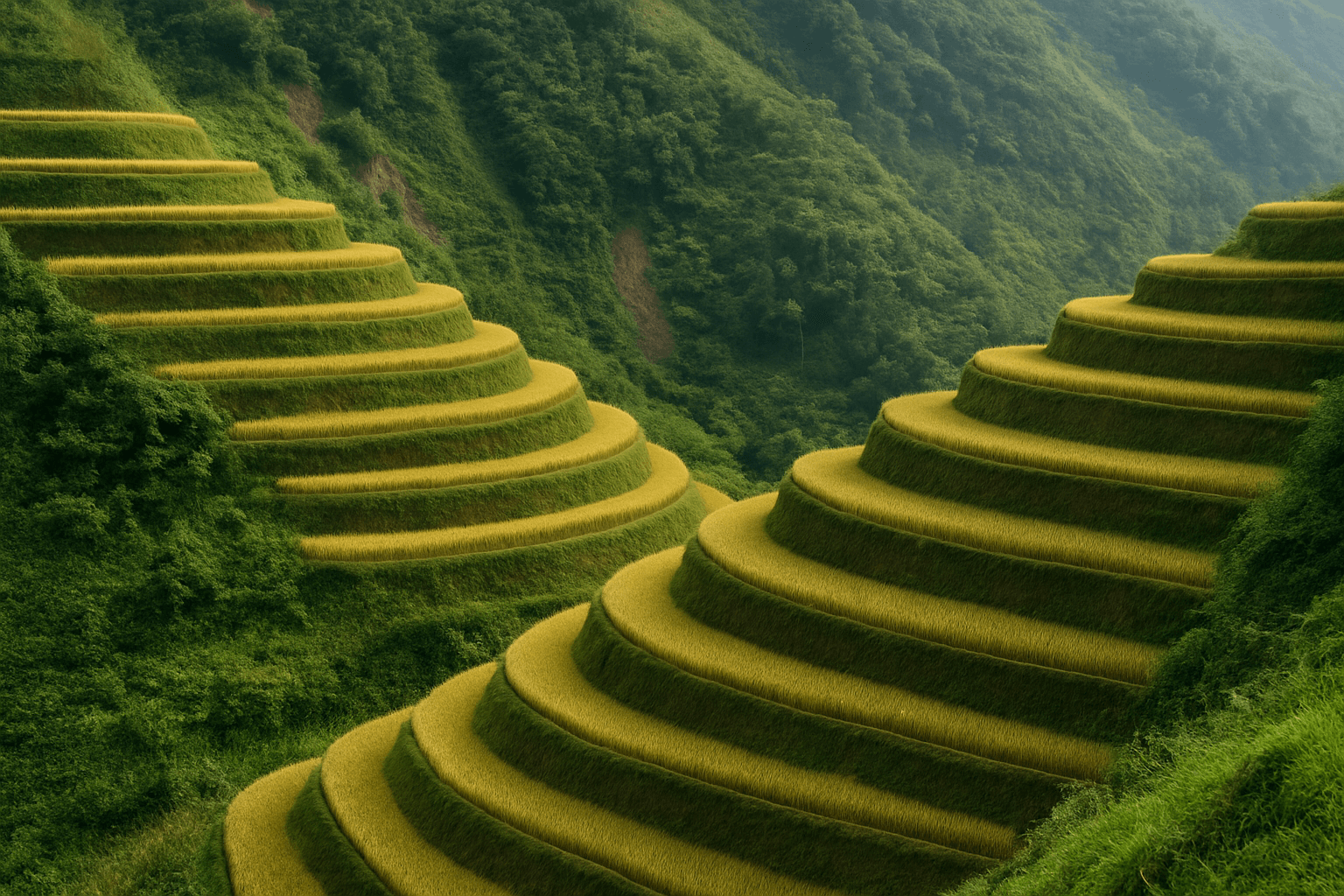
Broad-Base Terraces
Used on gentler slopes (up to 10% grade). These are wide and subtle, designed specifically so that farm machinery can be driven across them, making them suitable for large-scale, mechanized terraced farm systems.
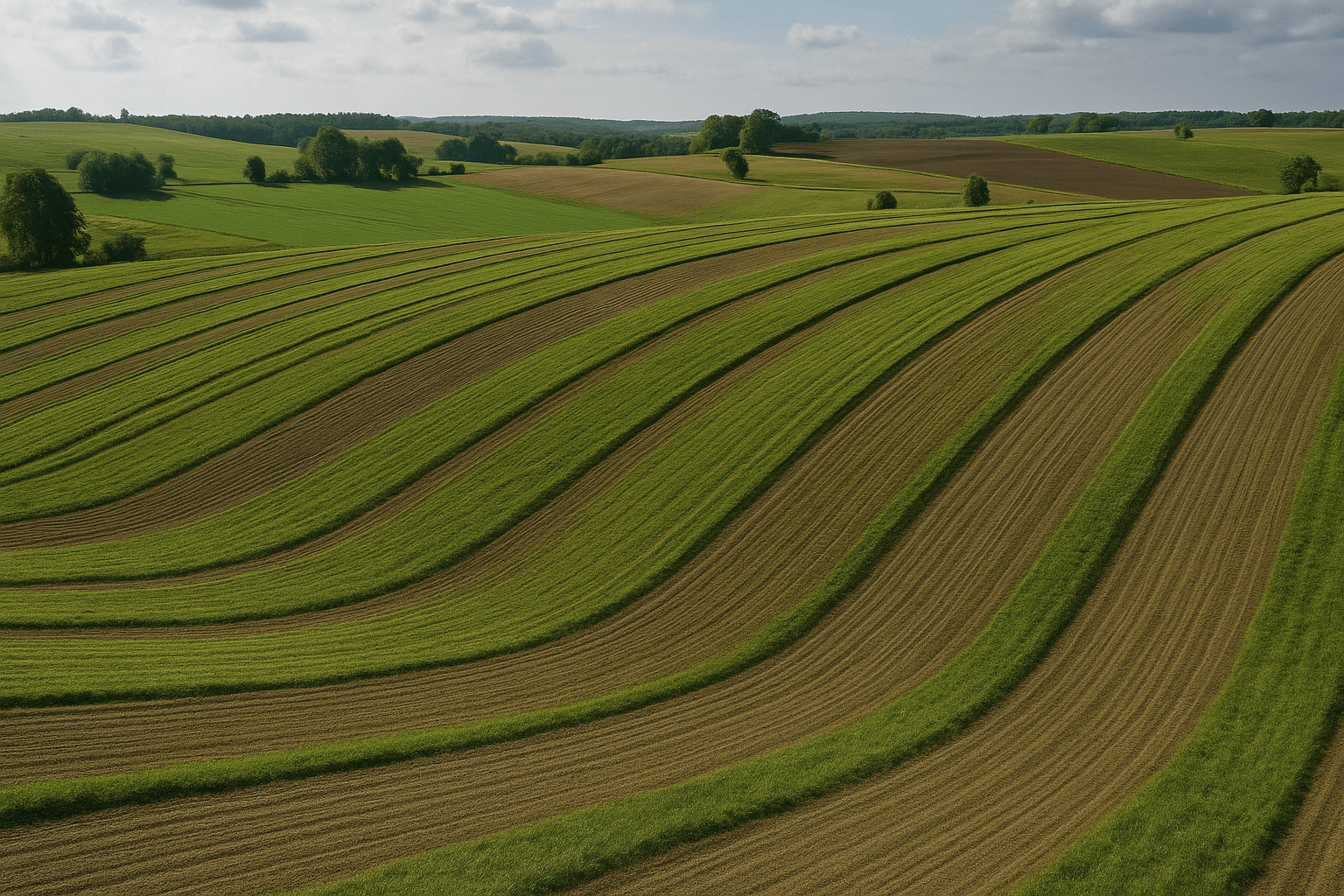
Narrow-Base (Grassed Backslope) Terraces
Used on medium slopes where the riser is stabilized with grass or permanent vegetation to maximize soil stability and minimize maintenance.
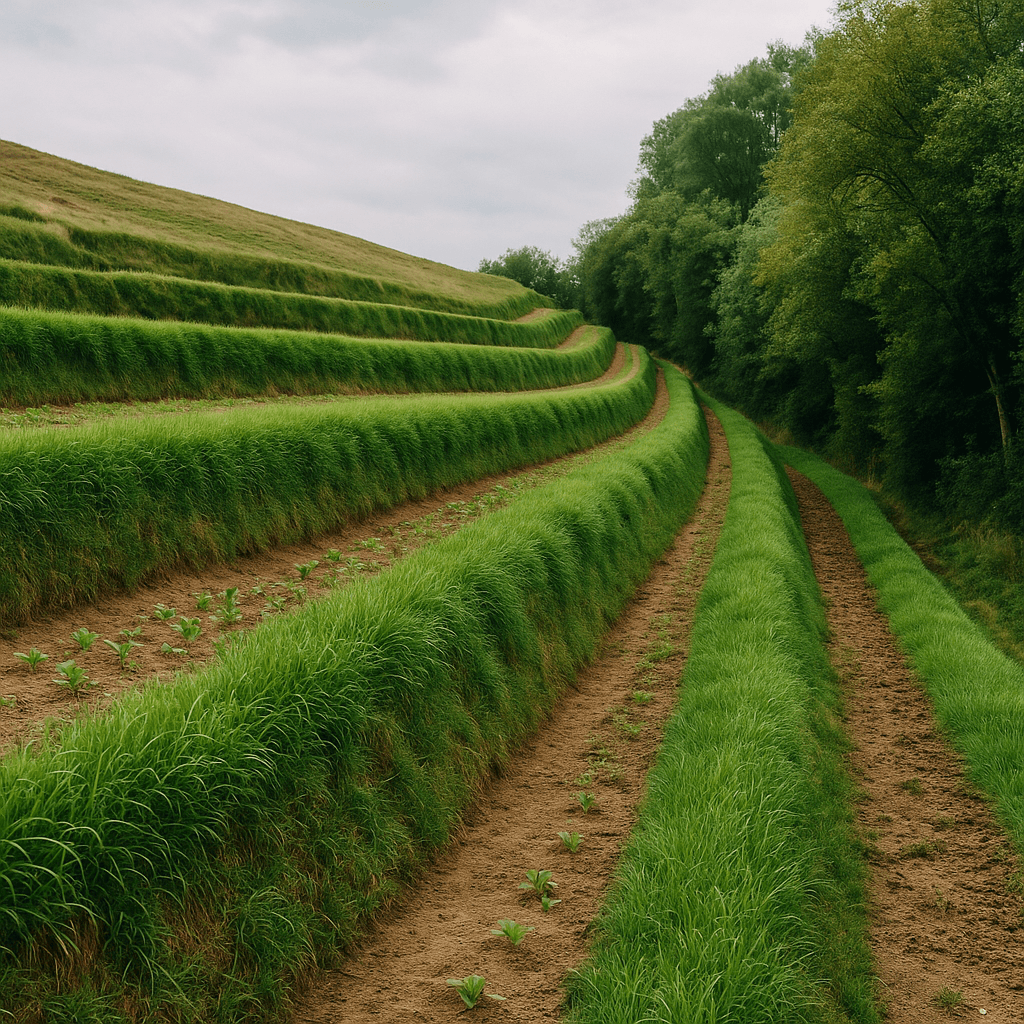
Parallel Terraces
Modern systems often attempt to maximize parallel rows between risers to improve efficiency for GPS-guided equipment. Non-parallel sections may be seeded with grass or dedicated to other uses.
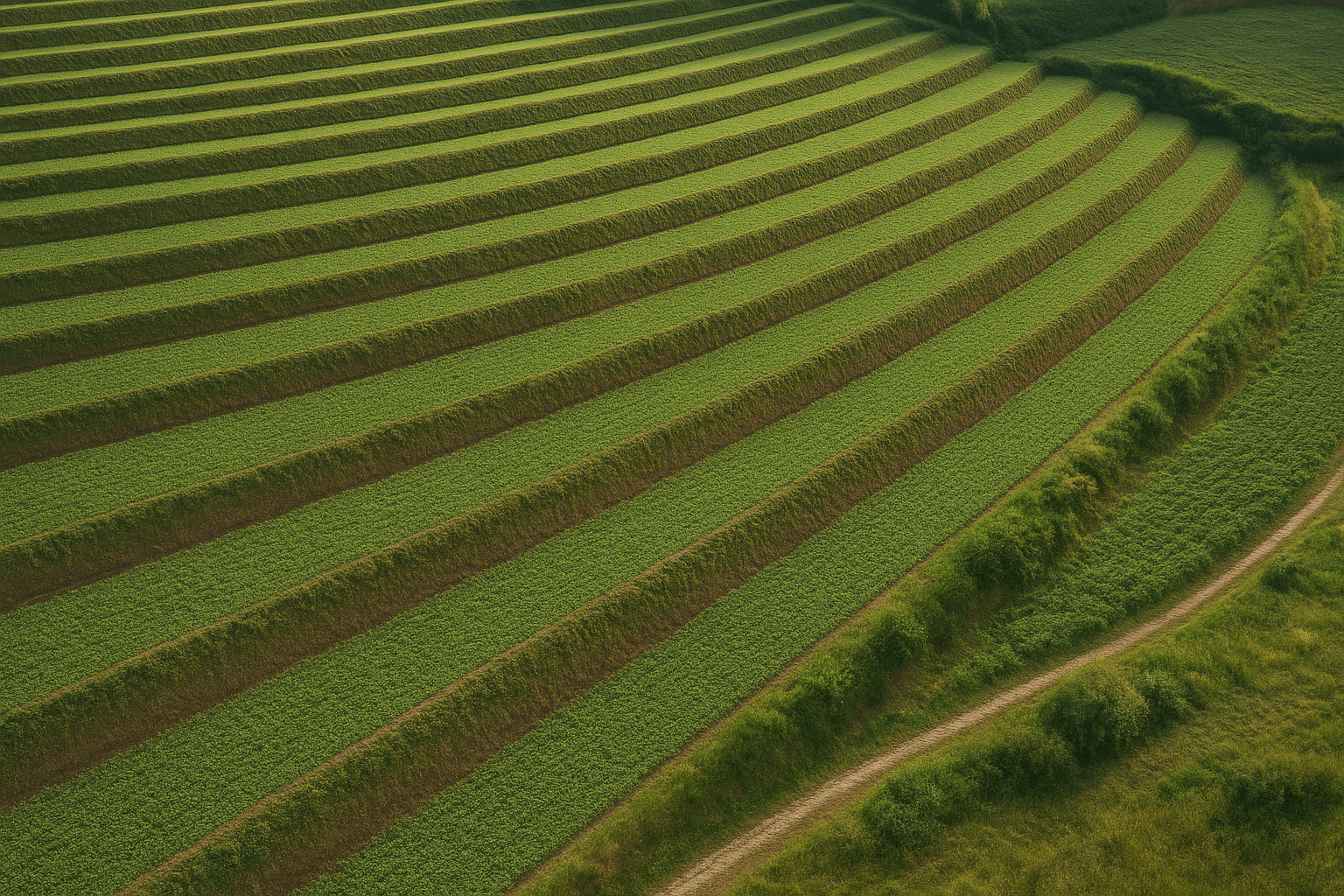
Contour Terraces
While sometimes used interchangeably with bench terraces, contour plowing (tillage following the natural elevation lines) is often the precursor to, or a simpler form of, terracing farming, especially when combined with strip cropping.
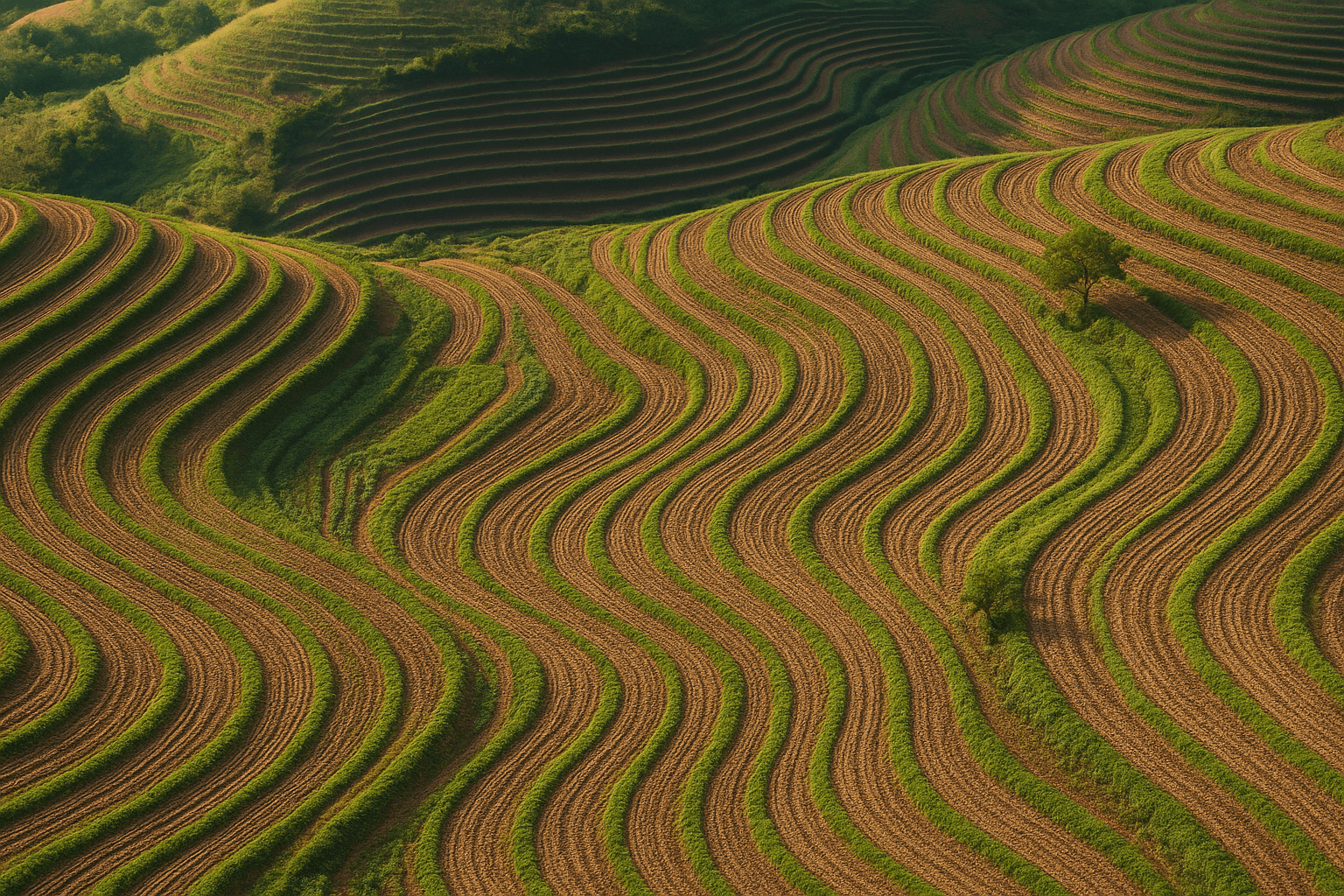
6. Engineering Considerations: Slope, Grade, and Design
Building an effective agricultural terrace is an engineering task. The design depends fundamentally on the land's original slope and the soil type.
- Slope Measurement: Accurate slope assessment is the first step. For example, a 15 percent slope means the land drops 15 feet over a horizontal distance of 100 feet. This measurement determines the required width and height of the terrace risers.
- Vertical Interval (VI): The vertical distance between the level benches must be carefully calculated. A smaller VI is needed for more erodible soils or steeper slopes.
- Level Grade vs. Graded Terrace: While many think of terraces as perfectly level, some systems use a slight grade (slope) on the bench itself. This *graded terrace* allows excess water to slowly drain off the field into protected grass waterways, preventing overflow and potential structural failure.
7. Economic and Environmental Benefits Of Terrace Farming
The advantages of a well-maintained terrace farm extend beyond just stopping erosion:
Economic Advantages:
- Increased Yields: By conserving water and topsoil, the fertility of the land is sustained, leading to more predictable and higher crop yields.
- Reduced Input Costs: Healthier soil with better moisture retention means less money spent on irrigation and replacing washed-away fertilizers.
- Land Value: Converting severely sloped land into usable terraced farm land increases the long-term productive value of the property.
Environmental Advantages:
- Water Quality Improvement: By trapping sediment, terraces prevent nutrient runoff into nearby rivers, reducing harmful algal blooms.
- Moisture Retention: Crucial in arid regions, the flat tiers trap and hold rainwater, reducing irrigation needs.
- Climate Resilience: Stronger soil and better water management help terraced farm systems cope with extreme weather events.
8. Crops Grown In Terrace Farming:
Virtually any crop can be grown on a terraced farm. The most iconic are paddy rice (requiring flooded, level benches), but others include maize, potatoes, wheat, vegetables, coffee, tea, and grapevines. The crop choice often dictates the required terrace type and water management system.
Is Your Sloped Field Losing Soil and Yields?
Visible signs of erosion and decreasing yields on sloped land are clear indicators that a change is needed. Terracing can be the solution, but it requires precise planning. Our high-accuracy elevation models can provide the engineering-grade data needed to design an effective and stable agricultural terrace system.
Get a DEM for Your Land9. The Precision Agriculture Connection: Satellite Crop Monitoring with XRTech Group
While the construction of agricultural terraces solves the physical challenge of farming on slopes, the management of these complex, compartmentalized fields requires advanced digital tools. XRTech Group’s specialized Satellite Data Applications, specifically the Agriculture Module, provides the critical geospatial data necessary for optimizing terraced farm production and ensuring soil longevity.
Traditional monitoring methods often struggle on uneven, tiered elevation. If a farmer sees visible signs of erosion or has decreased yields season by season, and the field elevation is uneven (sloped), it is worth opting for terracing to stop erosion and boost yields. However, even after terracing, managing nutrient and water inputs across the different tiers remains complex.
Using our crop monitoring system for agricultural fields, farmers can gain unparalleled insight:
1. Field Elevation Data for Precision Planning
XRTech Group provides high-accuracy Digital Elevation Models (DEM/DSM/DTM). These models feature 2–10 meter spacing and ±3m vertical RMSE, which is essential for engineering, hydrology, and land development. This data allows farmers to precisely map the elevation contours and slope stability of their newly established agricultural terrace system. This capability is critical for pre-construction planning and post-construction verification.
2. Productivity Zone Identification and Trend Analysis
Our multi-source satellite data and AI-powered agriculture imaging enable real-time monitoring of crop growth and health. We track vegetation health using indices like NDVI and Red Edge bands, enabling farmers to get data on field elevation and how the productivity of the field has changed over time. It shows the trend of how the vegetation was developing over a selected period. This is crucial because different tiers of a terraced field often have varying soil depths and microclimates.
3. Targeted Resource Management
With this information, a farmer can decide on productivity zones of the field and treat each zone differently (depending on the needs). This means fertilizer, water, and seed inputs can be optimized for each individual terraced farm section, moving away from wasteful blanket application and enhancing soil and fertility monitoring. This targeted approach, aided by remote sensing, helps monitor soil moisture for smarter irrigation strategies, reducing waste and protecting the newly conserved soil. This ensures the effort put into terracing farming is maximized.
XRTech Group makes precision agriculture accessible, scalable, and efficient. Our solutions ensure farmers can maximize yields and practice sustainable agriculture across the challenging terrains where terracing farming is utilized.
10. Frequently Asked Questions About Terrace Farming
1. What Is Terrace Farming?
Terrace farming is an agricultural method that involves cutting stair-like steps, known as agricultural terraces, into the sides of steep hills or mountains. This practice creates flat areas of land for cultivation, which dramatically reduces water runoff and soil erosion, making farming possible in challenging terrains.
2. What is the primary purpose of terrace farming?
The primary purpose is twofold: to make otherwise un-farmable sloped land suitable for growing crops, and to conserve vital topsoil and water. It controls the speed of water flow, ensuring water soaks into the soil rather than washing it away.
3. How does terracing help in conserving soil?
The flat, level steps of a terraced farm interrupt the downhill path of water runoff. This slows the velocity of the water, preventing it from carrying away topsoil. The contained water then has time to infiltrate the soil, which helps retain moisture and nutrients.
4. What is terracing in soil conservation?
Terracing in soil conservation refers to the engineering practice of shaping sloped land into level benches or steps. This practice is recognized globally as one of the most effective mechanical methods for controlling erosion and managing water on steep agricultural fields.
5. What are the common types of agricultural terraces?
Common types include Bench Terraces (the classic step-like structure), Broad-Base Terraces (wide, gentle slopes often used in less steep fields and adapted for machinery), and Narrow-Base or Grassed Backslope Terraces (designed for very steep slopes where the back riser is stabilized with grass).
6. Can satellite crop monitoring systems improve terraced farming?
Yes. Systems like those offered by XRTech Group provide high-accuracy Digital Elevation Models (DEMs) to map the physical structure and stability of the terraces. They also use vegetation indices (like NDVI) to monitor crop health and identify productivity zones across the different tiers for targeted resource management.
7. What kinds of crops are grown on a terraced farm?
Many different crops can be grown, depending on the region and climate. Common examples include rice (in flooded paddies), various vegetables, potatoes, grains like corn and wheat, and perennial crops such as coffee, tea, and grapevines.
8. How does terracing prevent and reduce soil erosion?
Terracing prevents erosion by converting long, steep slopes into a series of short, flatter sections. This reduces the velocity and erosive power of rainwater, ensuring that soil particles remain in place and are not washed down the hill.
9. Are terraced farm systems suitable for modern mechanized farming?
It depends on the type. Traditional, narrow-bench terraces are typically managed by hand. However, Broad-Base Terraces are specifically designed with gentle slopes to accommodate modern, large-scale farm machinery.
10. What satellite data does XRTech Group use for terracing analysis?
XRTech Group uses high-resolution satellite imagery to generate precise Digital Elevation Models (DEMs) for slope stability, and multi-spectral data (including Red Edge and NDVI) for monitoring crop health, nutrient needs, and productivity zone identification.
11. The Future of Slope Farming is Precision
The ancient wisdom of the agricultural terrace combined with the digital accuracy of satellite crop monitoring with XRTech Group is a powerful force for sustainable agriculture. By mitigating erosion and optimizing inputs, we help you protect the land, enhance your yields, and ensure the long-term viability of your farm.
References
- Advantages and disadvantages of terracing: A comprehensive review.
- Effectiveness of terracing techniques for controlling soil erosion.
-
A Review on Management Strategies of the Terraced Agricultural Systems and Conservation Actions.
Sustainability (MDPI). https://www.mdpi.com/2071-1050/13/8/4475
-
Soil and water conservation practices (including terracing) help mitigate drought effects — case studies from Ethiopia.
PMC / National Center for Biotechnology Information. https://www.ncbi.nlm.nih.gov/pmc/articles/PMC5985715/


